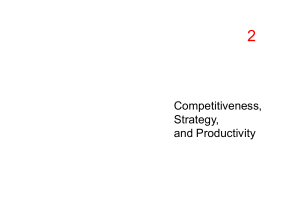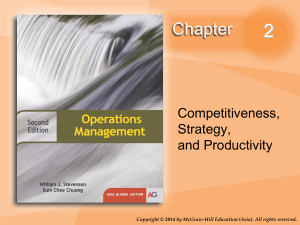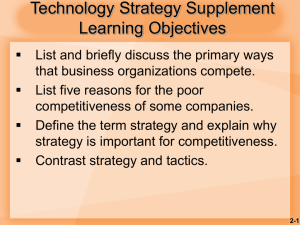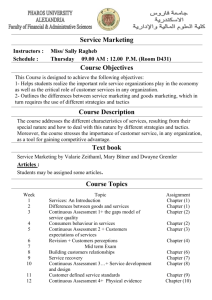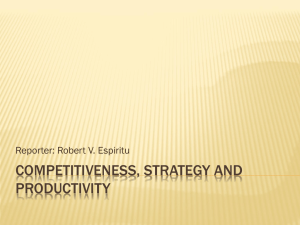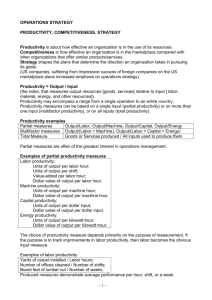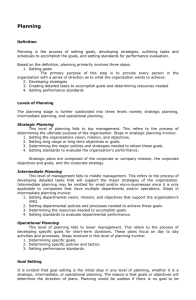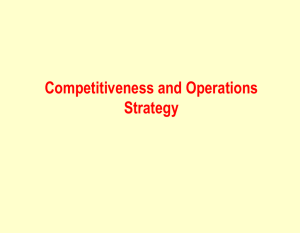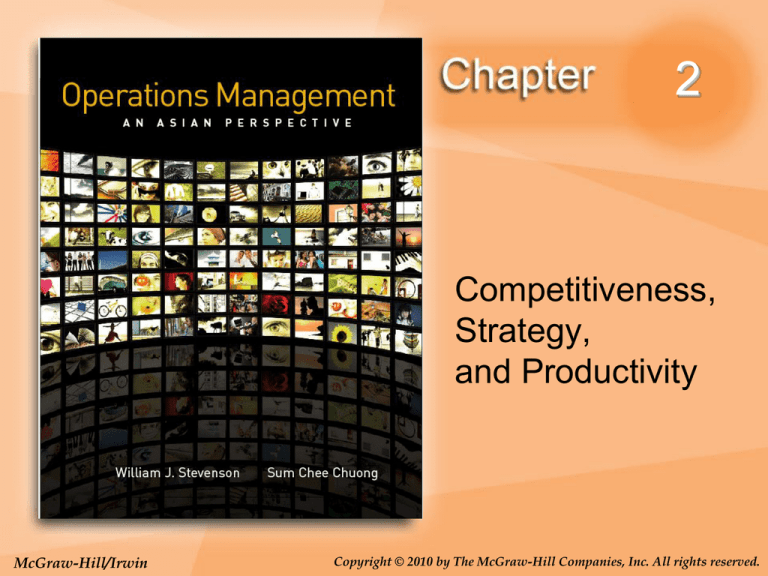
2
Competitiveness,
Strategy,
and Productivity
McGraw-Hill/Irwin
Copyright © 2010 by The McGraw-Hill Companies, Inc. All rights reserved.
Learning Objectives
List and briefly discuss the primary ways
that business organizations compete.
List five reasons for the poor
competitiveness of some companies.
Define the term strategy and explain why
strategy is important for competitiveness.
Contrast strategy and tactics.
2-2
Learning Objectives
Discuss and compare organization strategy
and operations strategy, and explain why it is
important to link the two.
Describe and give examples of time-based
strategies.
Define the term productivity and explain why
it is important to organizations and to
countries.
List some of the reasons for poor productivity
and some ways of improving it.
2-3
NEW PRACTICUM SCHEDULE
SEMESTER SIX (6)
EMPLOYER SUGGESTION
JOB OPPORTUNITIES
STUDENTS WERE OFFERED BUT CANNOT
ENTER THE JOB MARKET
SUGGEST PRIVATE ORGANIZATION
COMMENCE IMMEDIATELY
CANCEL IF ARRANGEMENT HAS BEEN
RULES FOR STUDENT
WEAR ONLY DECENT CLOTHES
NO T-SHIRT
NO SHORT
NO JEANS
WEAR ONLY SHOES.
NO SANDAL/ SLIPPER
SWITCH OFF HP
ATTENDANCE IS COMPULSORY
Competitiveness:
How effectively an organization meets the
wants and needs of customers relative to
others that offer similar goods or services
2-6
Businesses Compete
Using Marketing
Identifying consumer wants and needs
Pricing
Advertising and promotion
2-7
Businesses Compete
Using Operations
Product and service design
Cost
Location
Quality
Quick response
2-8
Businesses Compete
Using Operations
Flexibility
Inventory management
Supply chain management
Service and service quality
Managers and workers
2-9
Why Some Organizations Fail
Too much emphasis on short-term
financial performance
Failing to take advantage of strengths
and opportunities
Neglecting operations strategy
Failing to recognize competitive threats
2-10
Why Some Organizations Fail
Too much emphasis in product and
service design and not enough on
improvement
Neglecting investments in capital and
human resources
Failing to establish good internal
communications
Failing to consider customer wants and
needs
2-11
Mission/Strategy/Tactics
Mission
Strategy
Tactics
How do mission, strategies and tactics relate to
decision making and distinctive competencies?
2-12
Strategy
Mission
Explains the existence for an organization
Mission Statement
States the purpose of an organization
Goals
Provide detail and scope of mission
Strategies
Plans for achieving organizational goals
Tactics
The methods and actions taken to accomplish strategies
2-13
Planning and Decision Making
Figure 2.1
Mission
Organizational
Goals
Organizational Strategies
Functional Goals
Finance
Strategies
Tactics
Operating
Procedures
Marketing
Strategies
Tactics
Operating
Procedures
Operations
Strategies
Tactics
Operating
Procedures
2-14
Strategy Example
Example 1
Jun Hee is a high school student. She would like to
have a career in business, have a good job, and
earn enough income to live comfortably
Mission:
Goal:
Strategy:
Tactics:
Operations:
Live a good life
Successful career, good income
Obtain a college education
Select a college and a major
Register, buy books, take
courses, study
2-15
Examples of Strategies
Low cost
Scale-based strategies
Specialization
Flexible operations
High quality
Service
2-16
Strategy and Tactics
Distinctive Competencies
The special attributes or abilities that give an
organization a competitive edge.
Strategy Factors
Price
Quality
Time
Flexibility
Service
Location
2-17
Examples of Operations Strategies
Table 2.2
Price
Low Cost
National first-class postage,
Carrefour, Jetstar
Quality
High-performance design Sony TV, Lexus, Disneyland
and/or high quality
Consistent quality
Time
Rapid delivery
On-time delivery
Coca-Cola, PepsiCo, Kodak,
McDonald’s restaurants, UPS
Pizza Hut, FedEx
Flexibility
Variety
Volume
Burger King
McDonald’s
Service
Superior customer
service
Disneyland, HewlettPackard, IBM
Location
Convenience
Supermarkets, dry cleaners
2-18
Global Strategy
Strategic decisions must be made with
respect to globalization
What works in one country may not work in
another
Strategies must be changed to account for
these differences
Other issues
Political, social, cultural, and economic
differences
2-19
Strategy Formulation
Distinctive competencies
Environmental scanning
SWOT
Order qualifiers
Order winners
2-20
Strategy Formulation
Order qualifiers
Characteristics that customers perceive as
minimum standards of acceptability to be
considered as a potential purchase
Order winners
Characteristics of an organization’s goods or
services that cause it to be perceived as
better than the competition
2-21
Operations Strategy
Operations strategy: The approach
consistent with organization strategy,
that is used to guide the operations
function.
2-22
Strategic OM Decisions
Table 2.4
Decision Area
Affects
Product and service design
Costs, quality liability and environmental
Capacity
Cost structure, flexibility
Process selection and layout
Costs, flexibility, skill level, capacity
Work design
Quality of work life, employee safety, productivity
Location
Costs, visibility
Quality
Ability to meet or exceed customer expectations
Inventory
Costs, shortages
Maintenance
Costs, equipment reliability, productivity
Scheduling
Flexibility, efficiency
Supply chains
Costs, quality, agility, shortages, vendor relations
Projects
Costs, new products, services, or operating systems
2-23
Quality and Time Strategies
Quality-based
strategies
Focuses on maintaining or
improving the quality of an
organization’s products or
services
Quality at the source
Time-based strategies
Focuses on reduction of
time needed to accomplish
tasks
2-24
Time-Based Strategies
JAN
FEB
MAR
APR
MAY
JUN
Planning
Designing
Processing
Changeover
On time!
Delivery
2-25
Productivity
Productivity
A measure of the effective use of resources,
usually expressed as the ratio of output to
input
Productivity ratios are used for
Planning workforce requirements
Scheduling equipment
Financial analysis
2-26
Food Processor
Table 1.2
Inputs
Processing
Outputs
Labor
Metal sheets
Water
Energy
Cleaning
Making cans
Cutting
Cooking
Packing
Labeling
Canned
vegetables
1-27
Productivity
Partial measures
output/(single input)
Multi-factor measures
output/(multiple inputs)
Total measure
output/(total inputs)
Output
Productivity =
Input
2-28
Productivity
Determine the productivity of the following;
Four workers installed 720 square yards of
carpeting in 8 hours.
A machine produced 68 usable pieces in 2 hours.
A company that processes fruits and vegetables is
able to produce 400 cases of canned peaches in
half hour with 4 workers. What is labour
productivity
Output
Productivity =
Input
2-29
Productivity Growth
Productivity Growth =
Current Period Productivity – Previous Period Productivity
Previous Period Productivity
If Productivity increased from 80 to 84, find the
growth rate.
2-30
Measures of Productivity
Table 2.5
Partial
measures
Multifactor
measures
Total
measure
Output
Labor
Output
Output
Machine Capital
Output
Labor + Machine
Output
Energy
Output
Labor + Capital + Energy
Goods or Services Produced
All inputs used to produce them
2-31
Examples of Partial Productivity Measures
Table 2.6
Labor
Productivity
Units of output per labor hour
Units of output per shift
Value-added per labor hour
Machine
Productivity
Units of output per machine hour
Dollar value of output per machine hour
Capital
Productivity
Units of output per dollar input
Dollar value of output per dollar input
Energy
Productivity
Units of output per kilowatt-hour
Dollar value of output per kilowatt-hour
2-32
Example
Determine the multifactor productivity using the
following data:
7040 Units Produced
Cost of labor: $1,000
Cost of materials: $520
Cost of overhead: $2000
What is the multifactor productivity?
Ans. 2.0 units per dollar of input
2-33
Example : Solution
MFP =
Output
Labor + Materials + Overhead
MFP =
(7040 units)
$1000 + $520 + $2000
MFP =
2.0 units per dollar of input
2-34
Question
1. A wrapping paper company produced 2,000
rolls of paper one day. Standard price in RM1/roll.
Labour cost was RM160, material cost was
RM50, and overhead was RM320. Determine the
multifactor productivity
2. Suppose that a company produced 300 standard
bookcases last week using 8 workers and it
produced 240 standard bookcases this week using
6 workers. In which period was the productivity
higher?
2-35
Process Yield
Process yield is the ratio of output of good
product to input
Defective product is not included in the
output
Service example:
Ratio of cars rented to cars available to rent
2-36
Factors Affecting Productivity
Capital
Quality
Technology
Management
2-37
Improving Productivity
Develop productivity measures
Determine critical (bottleneck) operations
Develop methods for productivity
improvements
Establish reasonable goals
Get management support
Measure and publicize improvements
Do not confuse productivity with efficiency
2-38

